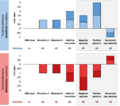Epistasis: Difference between revisions
CSV import |
CSV import |
||
| Line 33: | Line 33: | ||
[[Category:Genetic epidemiology]] | [[Category:Genetic epidemiology]] | ||
{{stub}} | {{stub}} | ||
<gallery> | |||
File:Epistatic_hair.png|Epistasis | |||
File:Epistasis.png|Epistasis | |||
File:Epistasis_bars.png|Epistasis | |||
File:Synergistic_versus_antagonistic_epistasis.svg|Synergistic versus antagonistic epistasis | |||
File:Epistasis_and_landscapes.png|Epistasis and landscapes | |||
</gallery> | |||
Latest revision as of 04:38, 18 February 2025
Epistasis is a phenomenon in genetics where the effect of one gene is dependent on the presence of one or more 'modifier genes', i.e. the genetic background.
Definition[edit]
The term epistasis was coined by William Bateson and Reginald Punnett in 1905, although at the time they did not know the molecular mechanisms behind the phenomenon. The term was derived from the Greek word 'epistasis', meaning 'stopping' or 'standing upon'. In the context of genetics, it refers to the effect of one gene being dependent on the presence or absence of one or more other genes.
Types of Epistasis[edit]
There are several types of epistasis, including:
- Recessive epistasis: This occurs when the presence of two recessive alleles inhibits the expression of an allele at a different locus.
- Dominant epistasis: This occurs when a dominant allele suppresses the expression of an allele at a different locus.
- Duplicate recessive epistasis: This occurs when two genes in a homozygous recessive state suppress the phenotype of the other.
Epistasis and Disease[edit]
Epistasis has significant implications in the study of diseases and disorders. For example, it is thought to play a role in the expression of Alzheimer's disease, cancer, epilepsy, and many other conditions. Understanding the mechanisms of epistasis can therefore be crucial in the development of treatments for these diseases.
See Also[edit]
References[edit]
<references />







